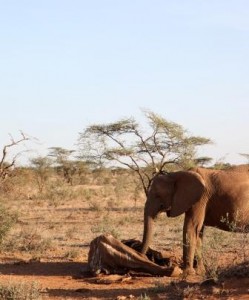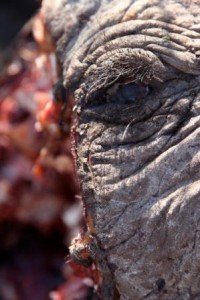The senseless and horrific death of Hope


A key segment of the new Nat Geo Wild documentary Blood Ivory – which will be screened again in the US tomorrow (September 24) – was shot in Kenya.
The aim was to document what was happening on the ground – there have been so many reports of poaching and seized ivory, in and through the country and at the airport – so when we arrived in March we immediately headed north to Samburu National Reserve, home to Save The Elephants (STE) study site, because the area had been identified as a poaching hotspot. If you head just a little further north then you’re in real bandit territory, scene of the recent kidnapping of a British tourist.
Three weeks earlier, two matriarchs from one of the STE study groups (the Virtues) had been shot: Enthusiasm and Resilience. Enthusiasm died relatively quickly but Resilience, true to her name, managed to get back to the sanctuary of the reserve, despite having been shot twice. She survived for a couple of weeks before she had to be put out of her misery. All of this was documented and the distressing scenes can be viewed in the documentary.
People sometimes ask me how I can do my job. Actually, I don’t know how the folk at STE do theirs. EIA’s work is in many ways at one remove from the grim reality of poaching because we are focusing on the trade; so it’s rare for us to be present at the immediate aftermath of a poaching incident. These guys get to know the elephants intimately: their families, their characters and intrinsic value to their close family groups and environment. The loss of each elephant is a personal one.

A lone elephant mourns over the remains of Resilience (C) EIA
On arrival at STE HQ, and after a very warm welcome from Iain Douglas Hamilton and his right-hand man David Daballen, we departed immediately to view the remains of Resilience. We were not alone. Another elephant from a different family group was also there, paying her last respects in a poignant and touching tribute. How privileged we were to witness such a moment.
But it was getting dark, so we headed back to camp. No sooner had we returned, just before 7pm, than the following sequence of events unfolded:
• Radio alert 1: An informant in a nearby village (close to the newly constructed road to Isiolo, gateway to the north and last chance saloon before the wild west that is Samburu) calls to report shots fired and elephant alarm calls. We need to get Kenya Wildlife Service (KWS) to the scene ASAP – that shouldn’t be too difficult as its base is only a couple of kilometres from the village, a 10-minute drive away;
• David, from STE, gets on the radio to alert everyone;
• Radio alert 2: The informant calls in again, about 10 minutes later, to reiterate the urgency. There have been more shots. More frantic radio calls are made;
• Radio alert 3: It’s the informant again; this time he can “hear them – on the elephant”, hacking off the tusks with machetes.
The whole thing is too hideous. It’s too dark to go back to the village, especially if there are poachers with firearms, so we agree to regroup first thing in the morning to go and see what we already know has transpired. There was nothing we could do anyway.
We were a very subdued team that night, although I think it’s fair to say that the film crew were getting way more than they ever could have dreamt of, so were quietly congratulating their good fortune at being on the spot with the whole poaching story unfolding and documented in less than 24 hours. I don’t know how film and photo journalists do their jobs either; maybe looking through the eye of the camera provides immunity from the misery staring them in the face.
I don’t know about anyone else, but I didn’t sleep much that night.
We arrived at the carcass of Hope early the next morning. Another matriarch and member of the Virtues, her two calves were nowhere to be seen.

The brutally mutilated remains of Hope (C) EIA
I’ve seen many dead elephants, but never one so recently poached and dispatched. Her face had been hacked off; the tusks whisked away to some nearby vehicle that would transport them to the middle man and then out to the waiting buyers in the Far East. All so easy, all so pointless.
We traced Hope’s last steps and pieced together her final terrifying moments as she had tried to dodge the spray of bullets, escape the poachers and protect her calves. She managed two out of three.
The entire ordeal probably lasted about 20 minutes and somewhere, probably not too far away, were two very frightened and disoriented young elephants. The search was on to find them. Combining all our resources, EIA, the film crew and STE deployed ground and air searches to find them. Bundu bashing (travelling through rough terrain) had never taken on such urgency. It was close to midday and hot as Hades and after what felt like many hours (in truth it was probably only an hour of concerted searching) we located what was left of the Virtues – minus Enthusiasm, Resilience and now Hope – five young elephants. That’s it.
And where was KWS in all this? Well, reports vary, but as far as we know they apparently showed up at around 10pm, three hours after the fact. Even the community Game Guards who had to get there on foot managed to reach the scene by about 8pm. I’m sure there is some explanation, but it certainly strikes me as very odd. And extremely disappointing.
In the meantime, the carnage continues all across Africa. Based on the information we have in our database for this year – and that is by no means complete – since January 1, 2011 (worldwide):
• 11,493kg of ivory have been seized; representing at least 1,149 elephants (based on an average of 10kg per animal);
• an additional 3,997 tusks (no weight recorded) were seized, so that’s at least 1,998 elephants;
• also seized were 1,307 pieces of ivory (worked ivory including statues, chopsticks, “pieces of ivory” with no further description, etc), with no way of knowing what that represents and no weight recorded.
This doesn’t include any of the ivory we know about that went through undetected – nor any of the shipments we don’t know about. So, not counting the ‘pieces’, that’s at least 3,148 dead animals.
If that represents 20 per cent of what goes through undetected – although customs will always say they reckon to stop about 10 per cent, but let’s be conservative – that means … well, you work it out.
Any way you look at it, the figure is both shocking and horrific.